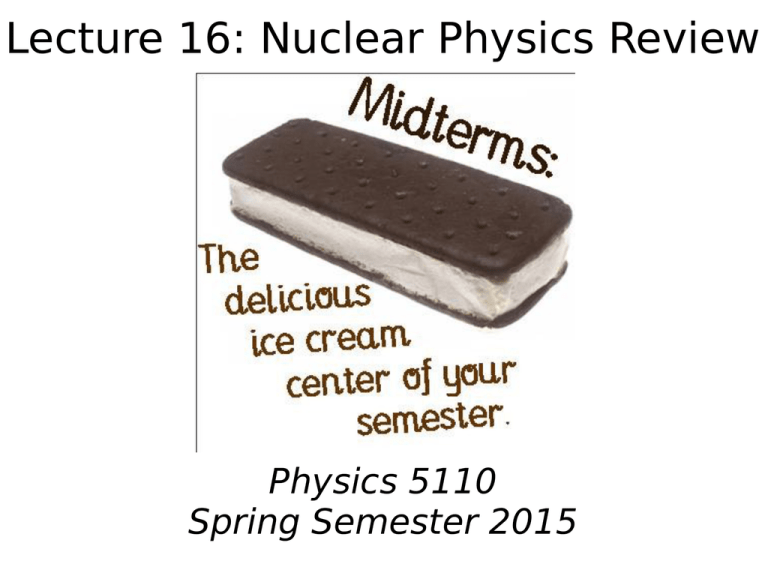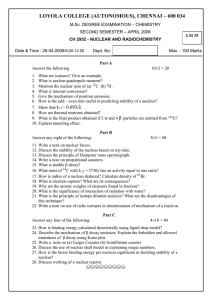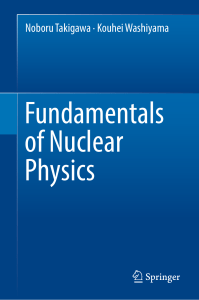Lecture 16: Nuclear Physics Review
advertisement

Lecture 16: Nuclear Physics Review Physics 5110 Spring Semester 2015 Midterm Exam ● Midterm on Monday March 2nd ● Allowed resources: ● ● – One sheet of paper with notes, equations – Calculator, pencil or pen Subject matter: Nuclear physics – Short work out problems – Short answer Study homeworks, lecture examples, practice exams. Chapters/Topics ● Rutherford Scattering ● Nuclear Phenomenology ● Nuclear Models (liquid drop, shell) ● Radiation () ● Applications (fission, fusion, decay) Ch 1: Rutherford Scattering ● Differential cross section d/d ● Rutherford d/d ● Possible short answer questions – What is a differential cross section? – Explain how Rutherford scattering demonstrates that there is a nucleus. – What are Mandelstam variables s,t,u, and what do they signify physically? Sample Rutherford work-out problem Result from Lecture 2 Hits recorded by detector ● N0 = number of beam particles ● ,t = target density,thickness ● A0, A = Avogadro's #, Atomic mass Solid angle of detector Differential Cross Section (physics) Classical Scattering Theory (Fixed Target) Do the math... ● And after some arithmetic (homework) Ch 2: Nuclear Phenomenology ● Nuclear mass, size, spin, stability. ● How do we know the above? ● Possible short answer questions – What is a form factor? – Explain how we can know the size of an atomic nucleus. – What is binding energy, how is it determined? Size of Nucleus ● Method suggested by diffraction of light ● Scatter particles of = h/p off of nucleus Ch 3: Nuclear Models ● Liquid Drop Model ● Shell Model ● Possible short answer questions – Describe origin of term(s) in semiempirical mass formula – Describe role of spin-orbit interaction in the shell model Goal of Nuclear Models ● ● Can we model this curve? Can we make other predictions? The Semi-Empirical Mass Formula (Bethe-Weizaecker) volume Coulomb surface pairing asymmetry “Pairing Term” ● PP and NN are more strongly bound than PN. ● Introduce a term that has – Greater BE for ZevenNeven. – Zero BE for ZevenNodd or ZoddNeven. – Less BE for ZoddNodd. + o-o − e-e 0 o-e Phenomenological A dependence Spin Orbit Effect in Shell Model So the total splitting is given by: → splitting increases for larger l → can produce “level crossing” → hence desired shell structure! Unpaired nucleons provide spin-parity assignment: ● ● ● Even-even nuclei → have zero spin (observed) Odd-Odd nuclei → can't predict :-( (we don't know how N-P will pair) Odd-Even (i.e. odd A) nuclei – Determine which type of nucleons is oddnumbered – Count odd nucleons to determine filled shells – Spin-parity of last nucleon is that of nucleus Examples: Use shell model to estimate spin-parity and magnetic dipole moment of... ● Tritium 3H1 ● Lithium 7Li3 ● Carbon 11 C6 Ch 4: Nuclear Radiation ● Alpha, Beta, Gamma Decays ● Possible short answer questions – Describe the role of “tunneling” in nuclear decays. – Differentiate between the three types of “beta” decay. – Describe how we infer the existence of neutrinos from beta decay Ch 5: Applications of Nuclear Physics ● Fission ● Fusion ● Radioactive decay law ● Possible short answer questions – What is difference between spontaneous and induced fission? – Interpret “Neutrons in Natural Uranium” plot. – Explain the “moderator” in fission reactors. – Why do we fuse light nuclei and “fiss” heavy nuclei to produce energy? Neutron interactions in Natural Uranium





